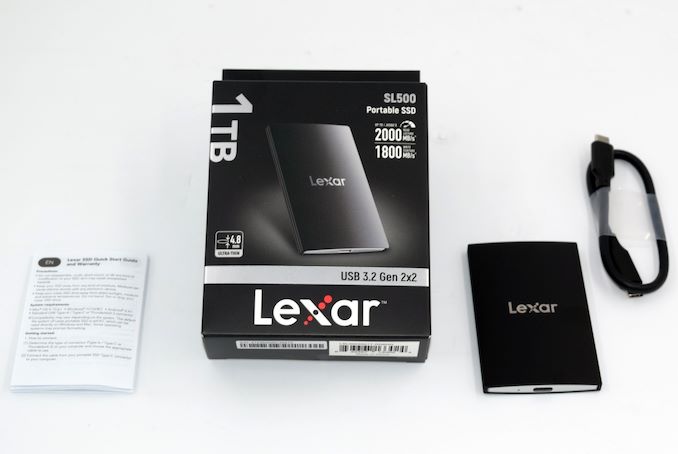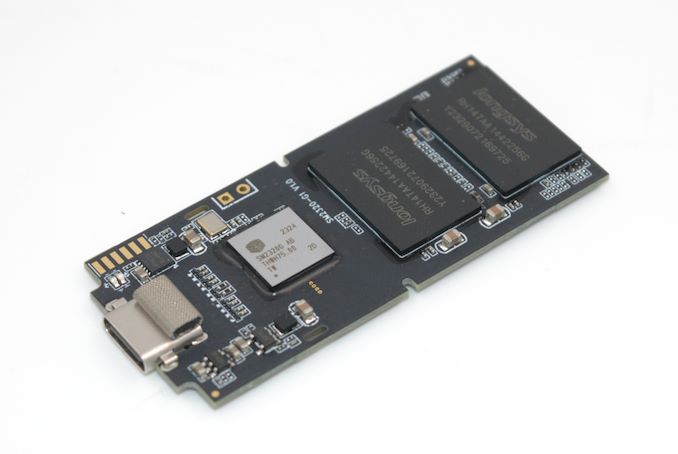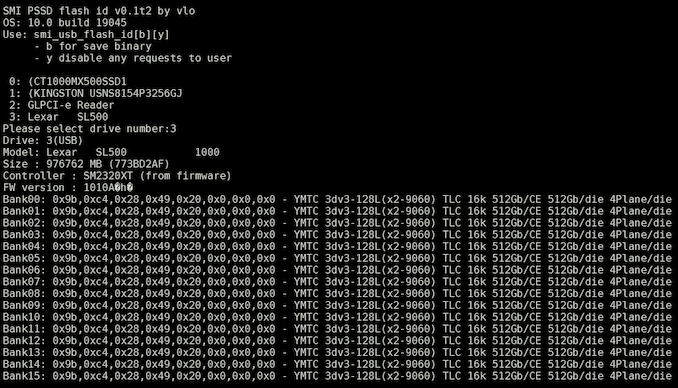
Original Link: https://www.anandtech.com/show/21357/lexar-sl500-portable-ssd-review-silicon-motion-sm2320-and-ymtc-nand-in-a-potent-package
Lexar SL500 Portable SSD Review: Silicon Motion SM2320 and YMTC NAND in a Potent Package
by Ganesh T S on April 23, 2024 8:00 AM EST- Posted in
- Storage
- SSDs
- Lexar
- DAS
- Silicon Motion
- YMTC
- Portable SSDs
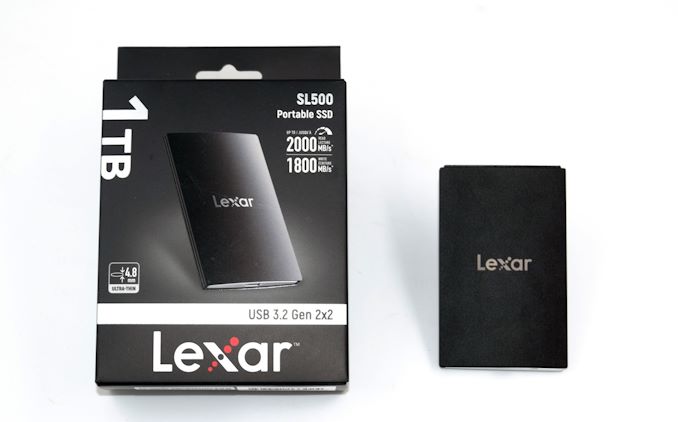
Lexar has a long history of serving the flash-based consumer storage market in the form of SSDs, memory cards, and USB flash drives. After having started out as a Micron brand, the company was acquired in 2017 by Longsys which has diversified its product lineup with regular introduction of new products. Recently, the company announced a number of portable SSDs targeting different market segments. The Lexar SL500 Portable SSD is one of the moderately priced 20 Gbps PSSDs in that set.
The SL500 is able to achieve its price point thanks to the use of a native USB flash controller - the Silicon Motion SM2320. The unique aspect is the use of YMTC 3D TLC NAND (compared to the usual Micron or BiCS NAND that we have seen in previous SM2320-based PSSDs). This review takes a detailed look at the SL500, including an analysis of its internals and evaluation of its performance consistency, power consumption, and thermal profile.
Introduction and Product Impressions
External bus-powered storage devices have been growing in storage capacity as well as access speeds over the last decade. Advancements in flash technology (such as the advent of 3D NAND and NVMe) and the evolution of faster host interfaces (such as Thunderbolt 3 and USB 3.x / USB4). As a result, we have been seeing palm-sized flash-based storage devices capable of delivering 3GBps+ speeds. While those speeds can be achieved with Thunderbolt 4, mass-market devices have to rely on USB. Within the USB ecosystem, USB 3.2 Gen 2 (10 Gbps) is fast becoming the entry level for thumb drives and portable SSDs. USB 3.2 Gen 2x2 (20 Gbps) got off to a slow start, but recent computing platforms from both Intel and AMD have started to support it on the host side. The introduction of native USB 3.2 Gen 2x2 flash controllers such as the Phison U18 and Silicon Motion SM2320 has enabled PSSD vendors to bring low-cost power-efficient 20 Gbps external drives to the market.
Broadly speaking, there are currently five distinct performance levels in the PSSD market:
- 2GBps+ drives with Thunderbolt 3 or USB4, using NVMe SSDs
- 2GBps drives with USB 3.2 Gen 2x2, using NVMe SSDs or direct USB flash drive (UFD) controllers
- 1GBps drives with USB 3.2 Gen 2, using NVMe SSDs or direct UFD controllers
- 500MBps drives with USB 3.2 Gen 1 (or, Gen 2, in some cases), using SATA SSDs
- Sub-400MBps drives with USB 3.2 Gen 1, using UFD controllers
Within each of these levels, there is further segmentation into entry-level, mid-range, and premium based on the choice of internal components. The Lexar SL500 we are looking at today falls under the second category. Lexar touts the ultra-thin nature of the PSSD as a key selling point. The packaging itself is spartan - we have a discrete Type-C to Type-C cable, along with an user guide.
The casing is metal and exudes a sleek and premium look. However, there are no claims of ruggedness or any specific IP ratings. The unit does not have any screws and disassembling involves prying off the plastic tabs at either end and pushing out the internal plastic frame.
The plastic frame itself is a bit oversized for the board, but that seems to have been done keeping in mind the need to make the external casing palm-sized. The gallery below presents some insights into the case design and internals of the PSSD.
Interestingly, the board does not have any explicit thermal solution - no thermal pads or conducting paths to the external casing from either the controller or flash packages. The SM2320 UFD controller is directly visible on the board.
The 1TB version includes four flash packages in a double-sided configuration. The packages are from Longsys themselves with no obvious indication of the NAND inside. Fortunately, we have a publicly available NAND decoder tool for Silicon Motion PSSDs, and that reveals the use of YMTC's 128L 3D TLC inside the packages.
This review compares the Lexar SL500 against a host of other 2GBps-class PSSDs we have reviewed before. An overview of the internal capabilities of these PSSDs is given by CrystalDiskInfo. The SL500 supports full S.M.A.R.T passthrough, along with TRIM to ensure consistent performance for the drive over its lifetime.
| Comparative Direct-Attached Storage Devices Configuration | ||
| Aspect | ||
| Downstream Port | Native Flash | 1x PCIe 3.0 x4 (M.2 NVMe) |
| Upstream Port | USB 3.2 Gen 2x2 Type-C (Female) | USB 3.2 Gen 2x2 Type-C |
| Bridge Chip | Silicon Motion SM2320 | ASMedia ASM2364 |
| Power | Bus Powered | Bus Powered |
| Use Case | 2GBps-class, sleek and stylish palm-sized high-performance portable SSD with hardware encryption and a Type-C interface | Premium 2GBps-class, compact, and sturdy portable SSD in a gumstick form-factor targeting the gaming market |
| Physical Dimensions | 85 mm x 54 mm x (4.5 to 7.8) mm | 118 mm x 62 mm x 14 mm |
| Weight | 43 grams | 115 grams (without cable) |
| Cable | 30 cm USB 3.2 Gen 2x2 Type-C (male) to Type-C (male) | 30 cm USB 3.2 Gen 2x2 Type-C to Type-C 30 cm USB 3.2 Gen 2 Type-C to Type-A |
| S.M.A.R.T Passthrough | Yes | Yes |
| UASP Support | Yes | Yes |
| TRIM Passthrough | Yes | Yes |
| Hardware Encryption | Yes | Not Available |
| Evaluated Storage | YMTC 128L 3D TLC (packaged by Longsys) | Western Digital SN750E PCIe 3.0 x4 M.2 2280 NVMe SSD SanDisk / Toshiba BiCS 4 96L 3D TLC |
| Price | $118 | USD 210 |
| Review Link | Lexar SL500 1TB Review | WD_BLACK P50 Game Drive SSD 1TB Review #1 (2020) WD_BLACK P50 Game Drive SSD 1TB Review #2 (2021) |
An interesting aspect of the Lexar SL500 that makes it stand out from the crowd is the availability of 256-bit AES encryption support using Lexar's custom password-protection software (that needs to be installed on all machines that need access to the contents).
Prior to looking at the benchmark numbers, power consumption, and thermal solution effectiveness, a description of the testbed setup and evaluation methodology is provided.
Testbed Setup and Evaluation Methodology
Direct-attached storage devices (including thumb drives) are evaluated using the Quartz Canyon NUC (essentially, the Xeon / ECC version of the Ghost Canyon NUC) configured with 2x 16GB DDR4-2667 ECC SODIMMs and a PCIe 3.0 x4 NVMe SSD - the IM2P33E8 1TB from ADATA.
The most attractive aspect of the Quartz Canyon NUC is the presence of two PCIe slots (electrically, x16 and x4) for add-in cards. In the absence of a discrete GPU - for which there is no need in a DAS testbed - both slots are available. In fact, we also added a spare SanDisk Extreme PRO M.2 NVMe SSD to the CPU direct-attached M.2 22110 slot in the baseboard in order to avoid DMI bottlenecks when evaluating Thunderbolt 3 devices. This still allows for two add-in cards operating at x8 (x16 electrical) and x4 (x4 electrical). Since the Quartz Canyon NUC doesn't have a native USB 3.2 Gen 2x2 port, Silverstone's SST-ECU06 add-in card was installed in the x4 slot. All non-Thunderbolt devices are tested using the Type-C port enabled by the SST-ECU06.
The specifications of the testbed are summarized in the table below:
| The 2021 AnandTech DAS Testbed Configuration | |
| System | Intel Quartz Canyon NUC9vXQNX |
| CPU | Intel Xeon E-2286M |
| Memory | ADATA Industrial AD4B3200716G22 32 GB (2x 16GB) DDR4-3200 ECC @ 22-22-22-52 |
| OS Drive | ADATA Industrial IM2P33E8 NVMe 1TB |
| Secondary Drive | SanDisk Extreme PRO M.2 NVMe 3D SSD 1TB |
| Add-on Card | SilverStone Tek SST-ECU06 USB 3.2 Gen 2x2 Type-C Host |
| OS | Windows 10 Enterprise x64 (21H1) |
| Thanks to ADATA, Intel, and SilverStone Tek for the build components | |
The testbed hardware is only one segment of the evaluation. Over the last few years, the typical direct-attached storage workloads for memory cards have also evolved. High bit-rate 4K videos at 60fps have become quite common, and 8K videos are starting to make an appearance. Game install sizes have also grown steadily even in portable game consoles, thanks to high resolution textures and artwork. Keeping these in mind, our evaluation scheme for portable SSDs and UFDs involves multiple workloads which are described in detail in the corresponding sections.
- Synthetic workloads using CrystalDiskMark and ATTO
- Real-world access traces using PCMark 10's storage benchmark
- Custom robocopy workloads reflective of typical DAS usage
- Sequential write stress test
In the next section, we have an overview of the performance of the Lexar SL500 in these benchmarks. Prior to providing concluding remarks, we have some observations on the PSSD's power consumption numbers and thermal solution also.
Performance Benchmarks
Benchmarks such as ATTO and CrystalDiskMark help provide a quick look at the performance of the direct-attached storage device. The results translate to the instantaneous performance numbers that consumers can expect for specific workloads, but do not account for changes in behavior when the unit is subject to long-term conditioning and/or thermal throttling. Yet another use of these synthetic benchmarks is the ability to gather information regarding support for specific storage device features that affect performance.
Lexar claims read and write speeds of 2000 MBps and 1800 MBps respectively, and these are backed up by the ATTO benchmarks provided below. ATTO benchmarking is restricted to a single configuration in terms of queue depth, and is only representative of a small sub-set of real-world workloads. It does allow the visualization of change in transfer rates as the I/O size changes, with optimal performance being reached around 512 KB for a queue depth of 4.

The Lexar SL500 makes its mark in the lower half of the pack in the overall PCMark 10 Storage Bench scores. Being held back at 1800 MBps writes because of the NAND and firmware configuration is one of the main reasons, but the loss in performance is offset by other factors discussed in the next section.
Miscellaneous Aspects and Concluding Remarks
The performance of the storage bridges / drives in various real-world access traces as well as synthetic workloads was brought out in the preceding sections. We also looked at the performance consistency for these cases. Power users may also be interested in performance consistency under worst-case conditions, as well as drive power consumption. The latter is also important when used with battery powered devices such as notebooks and smartphones. Pricing is also an important aspect. We analyze each of these in detail below.
Worst-Case Performance Consistency
Flash-based storage devices tend to slow down in unpredictable ways when subject to a large number of small-sized random writes. Many benchmarks use that scheme to pre-condition devices prior to the actual testing in order to get a worst-case representative number. Fortunately, such workloads are uncommon for direct-attached storage devices, where workloads are largely sequential in nature. Use of SLC caching as well as firmware caps to prevent overheating may cause drop in write speeds when a flash-based DAS device is subject to sustained sequential writes.
Our Sequential Writes Performance Consistency Test configures the device as a raw physical disk (after deleting configured volumes). A fio workload is set up to write sequential data to the raw drive with a block size of 128K and iodepth of 32 to cover 90% of the drive capacity. The internal temperature is recorded at either end of the workload, while the instantaneous write data rate and cumulative total write data amount are recorded at 1-second intervals.
| CrystalDiskMark Workloads - Power Consumption | |
| TOP: | BOTTOM: |
 |
|
 |
|
Despite the firmware differences, the power consumption profile is remarkably similar for the Lexar SL500, LaCie Rugged Mini, and the Crucial X10 Pro. The SL500 has slightly lower absolute peak numbers (3W vs. 4W), but the PSSD (like other SM2320 solutions) spends most of the time around the 2W mark. Unlike the LaCie Rugged Mini, the Lexar SL500 does have a true deep sleep mode after idling for around 20 minutes.
Final Words
The Lexar SL500 was introduced at CES 2024 along with a host of other PSSD solutions. This Silicon Motion SM2320 solution differentiates itself from other ones in two aspects - usage of YMTC's 128L 3D TLC and the availability of hardware encryption support. The company seems to be targeting different capacities for different markets. The US market seems to officially only have the 2TB SKU available for $190. The 1TB SKU for $120 ships from the UK. With prices of flash-based storage in a flux, it is not possible to make any comments on the value proposition of the Lexar SL500. However, based on current prices, the Crucial X10 Pro does seem to offer better value for money.
Our only quibbles with the Lexar SL500 are the capping of peak write speeds in the firmware configuration and the absence of a bundled Type-C to Type-A adapter (some vendors supply a cable with an affixed adapter, which is quite welcome when the PSSD is shared across multiple systems). Lexar does have other 2GBps-class PSSDs that reach 2000 MBps write speeds, but the SL500 is limited to 1800 MBps. It is not clear if this is a function of the NAND alone. On the plus side, the power consumption and heat generation are considerably lower compared to other SM2320 PSSDs. This means lesser BOM cost related to thermals.
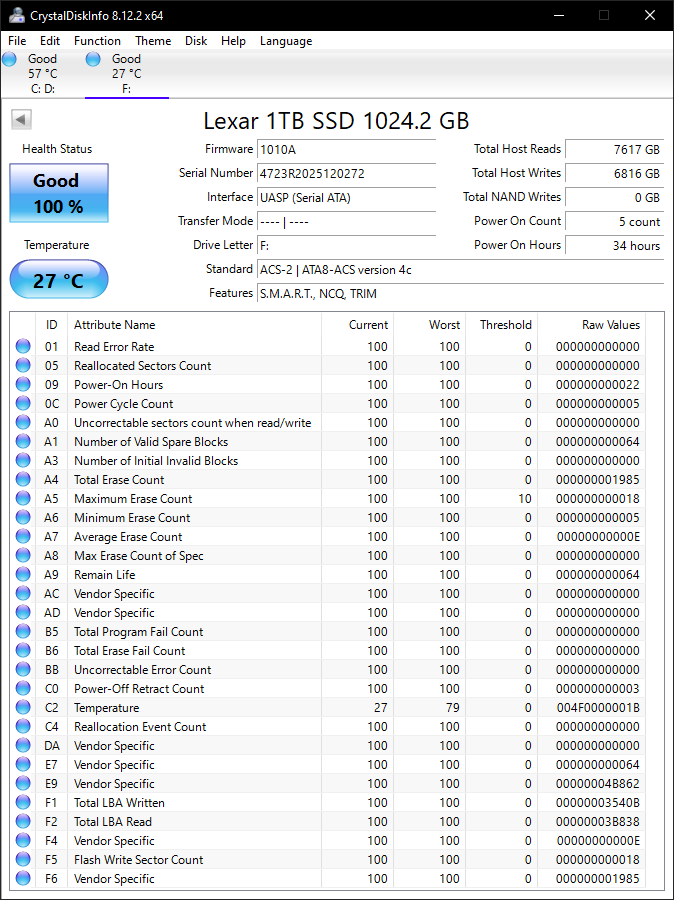
6.8TB+ writes, and 7.6TB+ reads at the end of our testing routine
The design of the casing is subjectively much better than some of the other SM2320-based PSSDs, and the company is right in stressing the ultra-thin nature of the PSSD in its marketing message. The SLC cache size at 38 GB is acceptable for most consumer / casual user workloads. In any case, the direct-to-TLC writes are also quite good at 1.3 GBps. Overall, this is a win for direct-attached storage workloads. On the general usage front, the random access numbers and the behavior for mixed workloads are a bit off - but it is unfair for consumers to expected native controller solutions to perform as well as bridge-based solutions using DRAM-equipped SSDs in that aspect. Overall, the Lexar SL500 shows the flexibility offered by Silicon Motion's SM2320 solution in good light. Depending on the exact use-case, consumers may find it a good alternative to the Crucial X10 Pro, LaCie Rugged Mini, or the Kingston XS2000.

